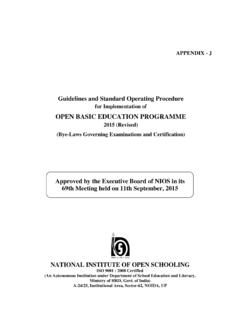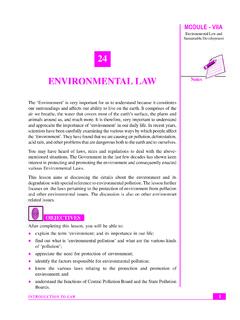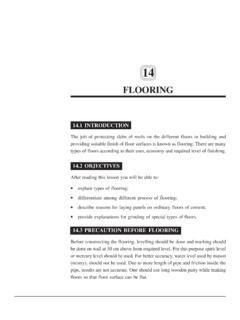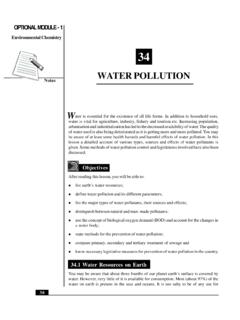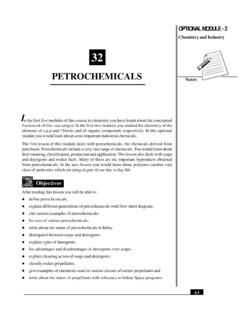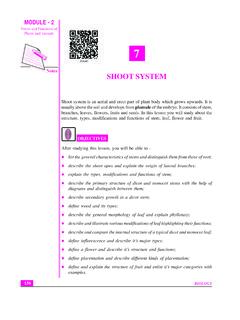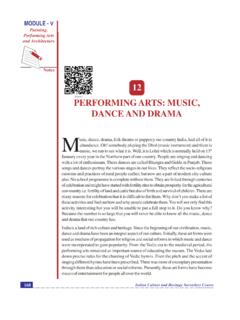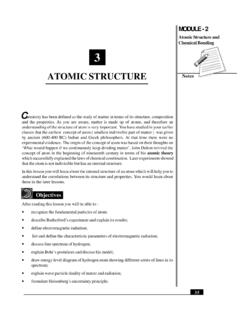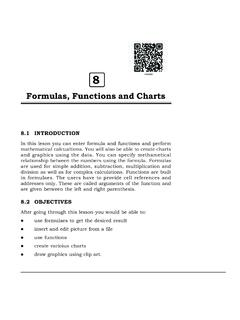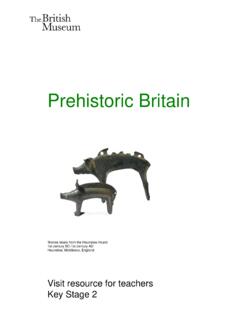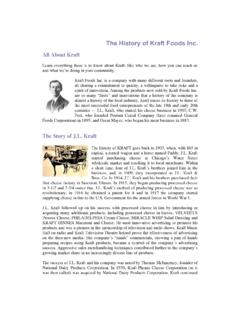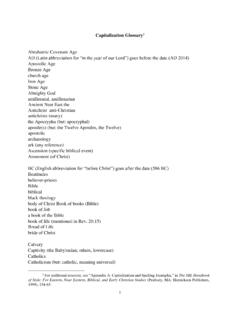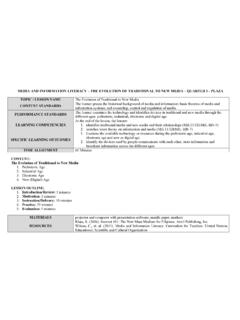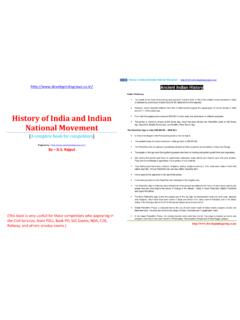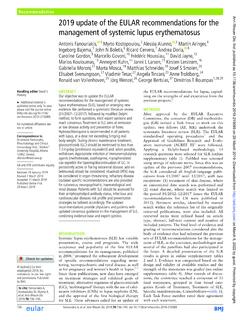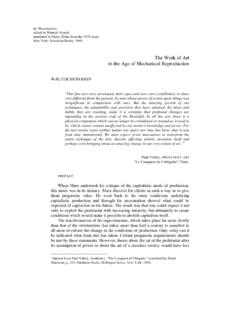Transcription of THE VEDIC AGE (1500BC 600BC)
1 48 HISTORYMODULE - 1 Ancient IndiaTHE VEDIC AGE (1500BC 600BC) 4 NotesIn the previous lesson, you read about the Harappan Civilization. The Harappans livedin cities and had a well organized trade and craft activities. They also had a script whichwe have been so far not able to decipher. However around 1900 BC these cities beganto decline. A number of rural settlements appeared afterwards. These rural settlementsshow continuity of certain Harappan elements. Around the same time we find archaeo-logical evidence of the arrival of new people known as Aryans or Indo-Aryans on theoutskirts of the Harappan region. In the present lesson, we shall study the circum-stances under which these new people arrived and also learn about the main featuresof their culture as depicted in the literature called the studying this lesson, you will be able to: learn about the VEDIC texts and the nature of their contents; know about the Aryans and identify the region from where they migrated; locate the regions inhabited by the early VEDIC (1500BC 1000BC) and the LaterVedic people (1000BC 600BC); explain the importance and impact of the use of iron implements which began inLater VEDIC period, and identify the changes which appeared in the economic, social, religious and politi-cal structures and institutions of the VEDIC people over a period extending from1000 BC to 600 BC.
2 THE VEDIC TEXTSWhat is veda? The word veda is derived from the root vid which means to know . Theword veda means the sacred knowledge contained in the texts known as VEDIC text. Twocategories of texts are included in the corpus of the VEDIC literature. These are Mantraand Brahmana. The Mantra category forms the core of the VEDIC texts and has fourseparate collections. These are the Rigveda, the Samaveda, the Yajurveda, and theAtharvaveda. The Brahmanas not to be confused with Brahaminical class are prosetexts containing the explanations of the mantras as well as the sacrificial rituals. The fourVedas together with their Brahmanas are also known as shruti or hearing , that whichwas directly heard by the sages. The Aranyakas (literally forest treatises) and theUpanishads (sitting down beside) are mainly appendices to the Brahmanas.
3 These arealso known as the Vedanta (end of the Veda) and contain philosophical - 1 Ancient IndiaNotesHISTORY The VEDIC Age (1500BC 600BC) The Rigveda is a collection of 1,028 hymns divided into 10 mandalas. They are theearliest compositions and hence depict the life of the early VEDIC people in India. TheSamaveda is a collection of verses mostly taken from the Rigveda but arranged in apoetic form to facilitate singing. The Yajurveda is found in two recensions, Black andWhite, and are full of rituals to be performed publicly or individually. The Atharvavedais a collection of magic spells and charms to ward off the evil spirits and studies have shown that the VEDIC texts reflect two stages of development interms of literature as well as social and cultural evolution. The Rigveda which is theoldest VEDIC text reflects one stage of social and cultural development whereas theother three Vedas reflect another stage.
4 The first stage is known as the Rigvedic periodor early VEDIC period and the later stage is known as the Later VEDIC period. The age ofthe early VEDIC period corresponds with the date of the composition of the Rigvedichymns. This date has been fixed between 1500 BC and 1000 BC. The later Vedicperiod is placed between 1000 BC and 600 BC. Recently, the Rigveda has been in-cluded by the UNESCO in the list of literature signifying World Human QUESTIONS do you understand by the term Veda? texts are included in the Mantra category of the VEDIC texts? Mention kind of texts are included in the category known as shruti? Mention the contents of the Brahmana category of the term MIGRATION OF THE ARYANSThe authors of the VEDIC hymns were the Aryans. But who were the Aryans? In the19th century, Aryans were considered a race.
5 Now it is thought of as a linguisticgroup of people who spoke Indo-European language from which later emerged San-skrit, Latin, and Greek etc. This is reflected from the words in these languages whichare similar in sound and meaning. Thus the Sanskrit words matri and pitri are similarto the Latin mater and pater. Similarly, Inar of the Hittite (Turkey) language is similarto Indra of the Vedas. Suryyas and Maruttash of the Kassite (Mesopotamia) inscrip-tions are equivalent of the VEDIC Surya and the Aryans seem to have lived somewhere in the Steppes stretching fromsouthern Russia to Central Asia. From here, a group of them migrated to northwestIndia and came to be called Indo-Aryans or just Aryans. The archaeological evi-dence of migrations comes from what is known as Andronovo Culture situated in south-ern Siberia. This Culture flourished in the second millennium BC.
6 From here peoplemoved to north of Hindukush (the area known as Bactria-Margiana ArchaeologicalComplex) and from here they entered India. During the period between 1900 BC50 HISTORYMODULE - 1 Ancient IndiaNotes The VEDIC Age (1500BC 600BC) and 1500 BC we get, in these regions, evidence of horses, spoked wheels, fire cultand cremation which formed important parts of Aryan life in India. Apart from these,the artifacts and ceramics also suggest movement of people from Central Asianregion to South Asian region. However it may be noted that some scholars still arguethat the Aryans were the indigenous people of India and that they did not come from new people came in several batches spanning several hundred years. All this whileinteraction between the indigenous inhabitants and the newcomers continued. One ofIZANCIENT CIVILAATIONSOF EURASIA3500-1500 Centers ofEurasian CivilizationLater Migration RoutesIndusHwang EUROPEANSCASPIANSEAARYANSITALIAN PEOPLESANDDORIANSACHAEANSHITTITESPERSIAN ASSYRIANSHPKSOSINDUSC.
7 2500 3500 3000 1500 2500 Ancient Civilization of Eurasia51 MODULE - 1 Ancient IndiaNotesHISTORY The VEDIC Age (1500BC 600BC) the important results of this process of interaction was that the VEDIC form of the Aryanlanguage became predominant in the entire Northwestern India. The texts composed inthis language, as mentioned above, are popularly known as the VEDIC QUESTIONS do we know that Sanskrit, Latin, Greek, Hittite and Kassite languages be-long to one group? where do we find the archaeological evidence of Aryan migrations? are the places which can be identified as the bearers of Aryan cultural traits? the prominent markers of the Aryan GEOGRAPHICAL HORIZON OF THE VEDIC ARYANSThe early VEDIC Aryans lived in the area known as sapta-sindhu meaning area of sevenrivers. This area largely covers the northwestern part of South Asia up to river seven rivers included Sindhu, Vitasta (Jhelum), Asikni (Chenab), Parushni (Ravi),Vipash (Beas), Shutudri (Sutlej) and the Sarasvati.
8 In this area the Rigvedic people lived,fought battles, grazed their herds of cattle and other domesticated animals. Graduallymoving eastward, they came to occupy eastern (Kosala) and north Bihar (Videha)during the Later VEDIC period. Here they came into contact with the people who spokelanguages different from their own and were living in this area for QUESTIONS the rivers included in the collective term which regions did the Aryans come into contact in the Later VEDIC period? early VEDIC ECONOMYThe early VEDIC Aryans were pastoralists. Cattle rearing was their main occupation. Theyreared cattle, sheep, goats, and horses for purposes of milk, meat and hides. We arrive at thisconclusion after analyzing the literary evidence in the Rigveda. A large number of words arederived from the word go meaning cow. A wealthy person was known as gomat and thedaughter called duhitri which means one who milks the cow.
9 The word gaveshana literallymeans search for cows, but it also means battle since many battles were fought over cows were thought of as providers of everything. Prayers are offered for increase in thenumber of cattle. All the above and many more references show that cattle breeding was themost important economic activity of the Rigvedic , this is not to suggest that the early VEDIC people had no knowledge of agricul-ture. The evidence for agriculture in comparison with pastoral activities in the early52 HISTORYMODULE - 1 Ancient IndiaNotes The VEDIC Age (1500BC 600BC) portions is meager and mostly late insertions. A few references show that they hadknowledge of agriculture and practiced it to supplement their food requirements. Theyproduced yava (modern jau or barley), which was rather a generic word for from cattle-rearing and small-scale cultivation, people were engaged in manyother economic activities.
10 Hunting, carpentry, tanning, weaving, chariot-making, metalsmeltry etc. were some such activities. The products of these activities were exchangedthrough barter. However, cows were the most favoured medium of exchange. Thepriests received cows, horses and gold ornaments as fees for performing QUESTIONS the main occupation of the early VEDIC a few examples which underscore the importance of the important was agriculture in the life of the early VEDIC Aryans? economic activities were the early VEDIC Aryans engaged in? Make a the system of exchange during the early VEDIC 80 90 70 80 35 25 35 25 1000100 ZONEMUJAVANTKAMBOJAGANDHARAS indhu (Indus)MARUMATSYAB rahmaputraPUNDRASAMUDRASAMUDRAARABIANSEA Y ovyayatiVipashSaraswatiSodaniraVarnavati GangaYamunaAMBASTHAHIMAVANTSAPTA SINDHAVAHKURUPARAVATAPRATISHTHADISHMADHY AMAVIDEHAKOSALAPRACHYAK ampilaMAGADHAN armadaVIDHARBHAMap Later VEDIC Zone53 MODULE - 1 Ancient IndiaNotesHISTORY The VEDIC Age (1500BC 600BC) CHANGES IN THE LATER VEDIC PHASED uring later VEDIC phase, agriculture became the mainstay of the VEDIC people.
